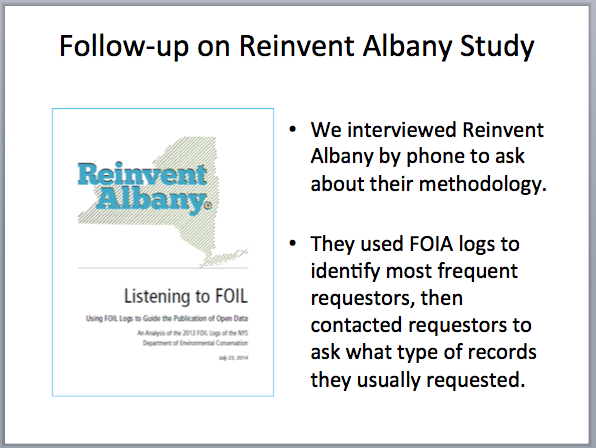Federal FOIA Advisory Committee “Listens to” Reinvent Albany
In June 2014, we published Listening to FOIL, a short report that used an analysis of the FOIL logs of the NYS Department of Environmental Conservation (DEC) to show that FOIL requests can be used as a tool to identify what data the public is seeking – and which should be published online as open data. At DEC, a handful of data sets contain the information being sought in a whopping 55% of FOIL requests. Our report created a stir in open data circles and was widely shared and caught the attention of the Federal FOIA Advisory Committee, which adopted and endorsed our Listening to FOIL report.
The Advisory Committee interviewed us to discuss our research. They also noted the federal General Services Administration has trialed similar practices: surveying frequent parties who file frequent FOIA requests, and asking requestors what data they would like to see opened.
The Committee attempted to examine the Environmental Protection Agency FOIA requests, but found fewer than 4,000 requests available to examine since January 2008. Nonetheless, they identified high-value data sets such as hazardous materials storage, permits, oil spills, superfund locations, water and air quality, and asbestos remediation records.
The next step for the FOIA Advisory Committee is to examine the process at one single agency, and get a comprehensive look at all FOIA requests. To date, they have relied on public information in the same way Reinvent Albany’s studies have. While it’s clearly still possible to perform this analysis with the public versions of FOIA logs, the actual FOIA logs in use at agencies may be more descriptive. Additionally, agency FOIA officers will simply have more familiarity with the kinds of data they work with day-to-day than we do.
Once agencies have begun looking to their FOIA requests, we recommend the “Willie Sutton” approach: you publish the data that people ask for most often, however they ask for it. In our post last March, we identified web site visits, phone calls, 311 requests, etc. as strong indicators that data is important to the public. Agencies should look at what web pages visitors gravitate to, what information 311 requestors most often seek, and then open the most-requested data. FOIA is just the first step.

